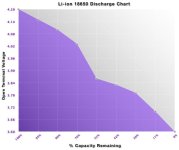xyster
10 MW
Welcome. Unless specified otherwise, the 72v controllers come with a 29 volt cut-off -- too low to use as a cut-off for your proposed lithium pack. Since you don't want to open it up, the CycleAnalyst, with a programmable LVC, is probably the best option:
http://www.ebikes.ca/drainbrain.shtml
Are you planning to build your own pack of 18650s? If you're using standard lithium-cobalt laptop cells (as opposed to the new Lithium Iron Phosphate 18650s), voltage monitoring is critical. The cells will overheat and die a smoky ugly death (if not catch fire or explode) if run down too far in a multi-cell pack. I've killed a couple dozen this way.

The voltage and charge state takes a nosedive below 3.70 volts per cell. There's no warning before the cells start overheating. Other than that, I've had no problems with my pack. I love the 100-mile range (@20mph, level ground, no pedaling) -- gives me plenty of margin to go exploring without worry I won't have enough to make it back.
A BMS can take care of the monitoring for you, or you can use a voltmeter (like on the CycleAnalyst) with or without a low-voltage cut-off. I use a cheap voltmeter and never ride below 3.75 volts per cell under no-load (75 volts on my 20s15p pack with my hand off the throttle).
To safely supply 40 amps, I'd recommend at least 15p.
How do you plan on charging, and balancing the cells?
http://www.ebikes.ca/drainbrain.shtml
Are you planning to build your own pack of 18650s? If you're using standard lithium-cobalt laptop cells (as opposed to the new Lithium Iron Phosphate 18650s), voltage monitoring is critical. The cells will overheat and die a smoky ugly death (if not catch fire or explode) if run down too far in a multi-cell pack. I've killed a couple dozen this way.

The voltage and charge state takes a nosedive below 3.70 volts per cell. There's no warning before the cells start overheating. Other than that, I've had no problems with my pack. I love the 100-mile range (@20mph, level ground, no pedaling) -- gives me plenty of margin to go exploring without worry I won't have enough to make it back.
A BMS can take care of the monitoring for you, or you can use a voltmeter (like on the CycleAnalyst) with or without a low-voltage cut-off. I use a cheap voltmeter and never ride below 3.75 volts per cell under no-load (75 volts on my 20s15p pack with my hand off the throttle).
To safely supply 40 amps, I'd recommend at least 15p.
How do you plan on charging, and balancing the cells?


